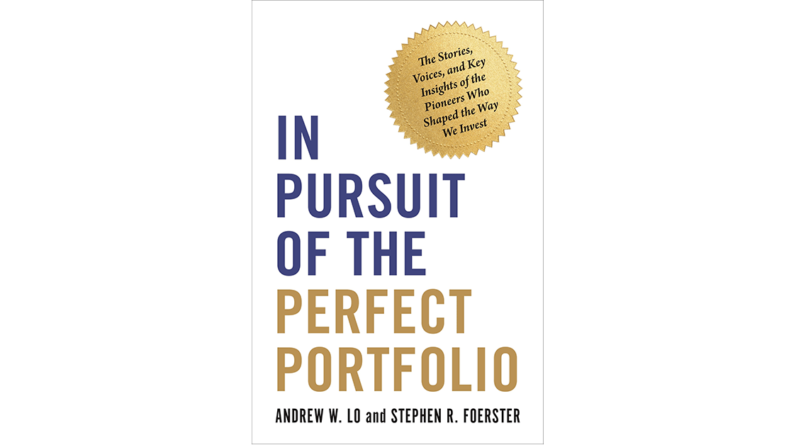
In Pursuit of the Perfect Portfolio: The Stories, Voices, and Key Insights of the Pioneers Who Shaped the Way We Invest. 2021. Andrew W. Lo and Stephen R. Foerster. Princeton University Press.
Between this book’s introductory and closing chapters, each of 10 famous superstars of finance receives a chapter of their own.
In the order in which they appear and with their primary contribution to what we know about investing, they are Harry Markowitz and portfolio selection, William Sharpe and the capital asset pricing model (CAPM), Eugene Fama and efficient markets, John Bogle and index investing, Myron Scholes and option pricing, Robert C. Merton and option pricing, Martin Leibowitz and the bond market; Robert Shiller and market irrationality, Charles Ellis and mutual index funds, and Jeremy Siegel and the long-run stability of real stock returns.
Two names, however, are conspicuous by their omission: the Omaha, Nebraska-based value-investing team of Warren Buffett and Charlie Munger. Munger’s name is absent, and Buffett’s receives only five short mentions, perhaps because of his directive to the trustee of his estate: “Put 10% of the cash in short-term government bonds and 90% in a very low-cost S&P 500 Index fund.”
In light of that counsel, it is worth noting that an investor who bought 100 shares of Berkshire Hathaway common stock at $15 a share after Buffett got control of it in 1965 and who still holds it would have a stake that, at this writing, is worth just under $56.4 million. That works out to a compounded annual rate of return of 20.3%. Had that same investor bought 100 shares of an S&P 500 Index fund for $173 a share in January 1965, that investment would be worth about $469,000 today for a compounded annual rate of return of just under 6%.
I emailed Lo and Foerster to inquire about the omission of Buffett and Munger. Each replied promptly. One wrote that the reason they were excluded is that so much had already been written about them. The other noted that “the focus of our book was to help readers understand the framework for thinking about portfolio construction” and that “most of these highly successful investors have devoted very little time and effort to educating investors on how to invest.”
The book’s opening chapter, “A Brief History of Investments,” begins with an extremely helpful graphic that shows the connections among the superstars, such as whether they were PhD classmates, extended or initiated teaching another’s work, received the Nobel Prize in the same year, etc. The chapter includes short sections about the evolution of investing as well as sections titled “Early Diversification” and “The Science of Investing in the Twentieth Century.”
Three chapters in particular, two that focus on investment pioneers — Sharpe and Bogle — and the final chapter, “So, What Is the Perfect Portfolio?” are especially compelling.
The Capital Asset Pricing Model
The opening paragraph of Sharpe’s profile rightly notes that CAPM was “an idea that forever changed the way portfolio managers approach their trade.” And that “Sharpe narrowed the focus of Markowitz’s portfolio idea and did more than any other financial economist to make the investment process more accessible for all of us.”
After obtaining his undergraduate degree in economics in 1955, Sharpe applied for jobs at banks. All of them turned him down because, he believed, they wanted B students, not ones who made straight As. He stayed in school, got a master’s degree in 1956, and joined the RAND think tank that same year.
Sharpe found that he had a knack for programming, which he truly enjoyed. While at RAND, he took night courses toward a doctorate in economics, which he received in 1958. Professor Fred Weston hired him as a research assistant and became one of his mentors. A second one, Armen Alchian (later of “Alchian and Demsetz” fame), “taught Sharpe how to question everything and how to analyze a problem from first principles.” That, in turn, enabled him to “critique his own work and to play the devil’s advocate when necessary.”
“Portfolio Analysis Based on a Simplified Model of the Relationships among Securities” was the title of Sharpe’s 1961 dissertation. The final chapter of that document, “A Positive Theory of Security Market Behavior,” eventually led to the development of the CAPM. That, in turn, resulted in the market portfolio, which we know today in the form of index funds. In September 1964, the Journal of Finance published his paper, “Capital Asset Prices: A Theory of Market Equilibrium under Conditions of Risk.” By 2021, the paper had generated over 26,000 citations.
Index Investing
Most investors who try to “beat the market” do not. That failure eventually gave rise to index funds or “passive investing.”1 The idea of an index fund originated with a three-page paper by Paul Samuelson in 1974. Bogle subsequently launched the first index mutual fund, First Index Investment Trust, in 1975. It began with assets of $11.3 million, a far cry from the $160 million Bogle had hoped to raise. First Index and a second fund became the Vanguard Group.
By the time Bogle died in 2019, the two funds had more than $5 trillion under management.
So, What Is the Perfect Portfolio?
After sections devoted to each luminary’s notion of the “perfect portfolio,” Lo and Foerster affirm the obvious: There is no such thing. They note that perfect health is the parallel of such a portfolio: There is no such thing, only degrees of it.
The authors do, however, offer a checklist of seven principles by which investors can construct their own “perfect portfolios.” These include such sound recommendations as determining the extent of one’s financial planning expertise and the amount of time and energy one is willing to devote to managing a portfolio, defining a comfort zone regarding gains and losses, and avoiding such mistakes as paying unnecessarily high fees and investing with active managers based on friendship.
Lo and Foerster also summarize the book in a table of 16 investor archetypes that classifies people according to their risk tolerance, income, and spending habits, while also accounting for the economic environment. Based on the category that best applies to them, individuals should pursue courses ranging from investing mostly in equities and staying the course to cutting spending and immediately consulting a financial adviser.
All in all, I highly recommend this book. I believe it is worth the time of neophytes and experienced investors alike.
1.The topic was published first in 2004 as “The Case for Indexing” by Nelson Wicas and Christopher B. Philips. Unfortunately, the original version is no longer available. However, an excellent explanation of index funds, their origins, and so on, is accessible via Investopedia.
If you liked this post, don’t forget to subscribe to the Enterprising Investor.
All posts are the opinion of the author. As such, they should not be construed as investment advice, nor do the opinions expressed necessarily reflect the views of CFA Institute or the author’s employer.
Professional Learning for CFA Institute Members
CFA Institute members are empowered to self-determine and self-report professional learning (PL) credits earned, including content on Enterprising Investor. Members can record credits easily using their online PL tracker.









